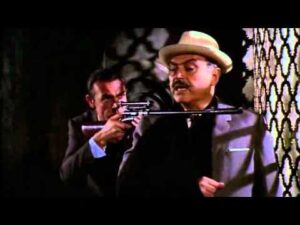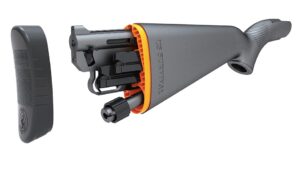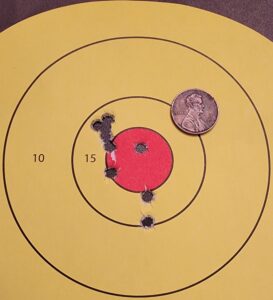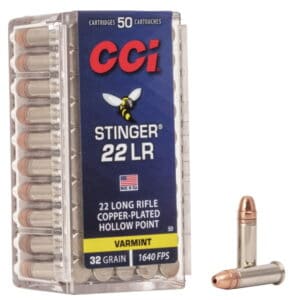In an iconic scene in From Russia with Love, James Bond assembles an ArmaLite AR-7 takedown rifle, removing the barrel and receiver from their storage slots in the weapon’s buttstock. Attaching a small scope, he scans for his quarry, the dastardly Krilencu, a Bulgarian assassin who works for SMERSH. Bond is about to take the shot when his ally, Kerim Bey, whom Krilencu had recently wounded in the shoulder, asks to pull the trigger, which he does with success. The scene ends with Kerim Bey remarking, “That pays many debts.”
Today, the Henry U.S. Survival AR-7 has replaced the older ArmaLite model, and while the .22 rifle may not repay the type of debts Kerim Bey was referring to, it will accomplish many tasks and just might keep you alive in the process. Henry says, “Don’t Leave Civilization Without One,” and while that is excellent advice, you may also need it when some elements in your day-to-day life become positively “uncivil.” It is a deadly rat gun.
Since 1959, when it was designed for U.S. Air Force flight crews that might have to bail out over rugged terrain, the AR-7’s reputation for portability, ease of operation and reliability has carried over to the civilian world, around the world. It is a favorite of bush pilots, backpackers and backcountry adventurers around the world who, like their Air Force counterparts, need a rifle that’s easy to carry, but also has the accuracy to reliably take down small game as food sources.
An eight-shot semi-automatic, it is lightweight (3.5 lbs.) and highly portable. At just 16.5″ long, when all the components are stowed, it easily fits into the cargo area of a plane, boat or in a backpack. Younger generations call some of these a “Bug Out Bag,”, but whatever your term, an AR-7 should really be in there. And stowed in your backpack, no one would ever have a clue that you are carrying a rifle. It’s almost as if you can make a rifle appear out of nowhere. Chambered in .22 LR, you can also carry a large quantity of ammunition without adding much weight to your gear.
When disassembled the pieces fit inside the impact-resistant, water resistant stock, which can float for a while, but get it out fairly quickly in case the back cap leaks; one reviewer tested that and the package remained waterproof for six minutes. Henry says, “Assembly is as easy as attaching the receiver to the stock, inserting the barrel, and screwing on the nut. In a few seconds, without any tools, the Henry AR-7 is ready for action.”
That’s not quite accurate. It is easy, but it will take at least a minute, not just a few seconds. But, remember, no tools are needed! The weapon comes with two 8-round magazines; order two more as the buttstock storage area will accommodate three loaded magazines.
To fire, you first attach the receiver to the stock by fitting it into the slot and turning a fixed little bolt until the two are tightly mated. This bolt is in the bottom of the handle and cannot come out when you unfasten the receiver, so it can’t get lost. Then you line up the barrel, and tighten the screw collar. Put in a magazine (and since you can store it with a magazine already in the receiver, you may want to consider that), pull the bolt back using the little charging handle, and release it; the bolt assembly slams forward, loading a round in the chamber. Unlike most other rifles, there is no bolt assembly stop to hold it to the rear, so after you fire your last round the bolt remains forward. You must pull the charging handle to the rear a bit to visually inspect the chamber to ensure there is no live round there, because it is blowback-operated. Fully assembled, it’s 35 inches long. With fifteen minutes of practice, maybe less, you can assemble it fully in the dark. The safety is a simple thumb lever that flips on and off easily.
The Henry AR-7 is available in three finishes; Black, True Timber Kanati Camo Pattern, and True Timber Viper Western Camo Pattern. There are two schools of thought on camo; one is you may want the rifle to hide along with you, but in the dark, if things go awry, you want to be able to find it quickly and easily. Either way, all models are equipped with an elevation-adjustable rear sight and a blade front sight that is windage-adjustable. The steel barrel covered in tough ABS plastic with a protective coating for complete corrosion resistance. Trigger pull is six-pounds and breaks cleanly. It’s made in Rice Lake, Wisconsin.
MSRP is about $290; for one of the two camouflage models, add another $60. I have tested one in black. The receiver has a narrow 3/8-inch groove design for rimfire rings. So I got a small, 4-power scope and rings, thinking I could increase accuracy. I shouldn’t have bothered. Since a scope-mounted receiver will not fit inside the butt compartment, you have to removed the scope before packing, and mount it again later for firing. This causes you to have to confirm the zero, which is often needed. The rabbit, rat or other target will not simply sit there waiting while you reconfirm the zero with a few shots, so clearly that won’t do. However, at fifty feet the front sight blade is easy to see through as it is orange. And the rear aperture peep sight is remarkably accurate; you should be able to hit the head of a squirrel, rabbit, duck or goose on the ground, to put in the cook-pot. That’s what the weapon is designed to do.
But the AR-7 can do much more. There is almost no recoil. You can fire all eight rounds in under four seconds and keep all eight on target. Sure, that won’t stop a bear, but it will drop or deter most mean-ass dogs. And in a pinch, my guess is that a two-legged predator isn’t going to like a face-full, or neck-full of CCI Stinger 32-grain hollow points. The advertised velocity is 1640 fps, but the AR-7, with its 16.125″ barrel gets 1496 fps, which is about 159 foot-pounds of energy. That’s not much as self-defense rounds go, but remember, the average shooter will be far more accurate with the AR-7 at fifty feet than they are with almost any pistol. At least that’s true in my case. And with that extra magazine you can stow, you’ve got 24 rounds for the fight. The AR-7 magazine release is located along the trigger guard, on the left side of the weapon. The shooter can use their trigger finger to push it forward to release the magazine, or your non-firing-hand thumb.
Even without a silencer, the AR-7 doesn’t make that much noise, and sometimes you don’t want every Tom, Dick or Harry to know you’re around, or blowing out your eardrums if you fire an emergency shot without hearing protection (although if at all possible, have some protection.) The Henry AR-7 isn’t a death ray. However, does a lot of things well-enough to get you by, and that’s exactly what this rifle is intended to do; get you by, until you are back home to safety.





